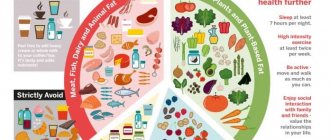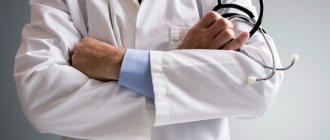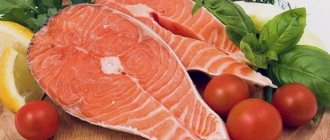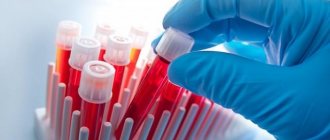What is the cause of hypercholesterolemia?
The most common cause of increased cholesterol levels is excess nutrition and a sedentary lifestyle. Modern man spends too few calories with a “full” diet. Hereditary predisposition plays a certain role.
In addition, hypercholesterolemia can be secondary and provoked by diseases such as:
- diabetes;
- decreased thyroid function (hypothyroidism);
- kidney damage in the form of nephrotic syndrome;
- liver dysfunction;
- genetic diseases (familial hypercholesterolemia).
Hypercholesterolemia can also occur while taking certain groups of pharmacological drugs.
These include:
- progestins;
- anabolic steroid;
- different types of immunosuppressants.
Risk factors for the development of hypercholesterolemia are:
- hereditary predisposition;
- excess body weight;
- low physical activity;
- chronic or acute stress.
3. Symptoms and diagnosis
As stated above, hypercholesterolemia is not a disease, which means, in particular, the absence of its own symptoms. The clinical picture is always determined by a specific combination of causes and consequences (for example, obesity and cardiovascular pathology, smoking and hemodynamic disorders in the lower extremities, cerebral transient ischemic attacks against the background of chronic stress, and many others).
Hypercholesterolemia is diagnosed through laboratory tests using special tabular criteria.
About our clinic Chistye Prudy metro station Medintercom page!
What can hypercholesterolemia lead to?
First of all, high cholesterol is the main factor in the development of atherosclerosis. Its deposits on the walls of blood vessels with the formation of atherosclerotic plaques pose a direct threat to all organs and systems of the patient.
Firstly, the lumen of the vessel itself narrows, which means that it begins to let in less and less blood, causing ischemia (oxygen starvation) of the organs that it supplies. The heart, kidneys and brain are primarily affected. The diameter of the vessels supplying these organs narrows due to the presence of atherosclerotic plaques, causing ischemia. With severe damage to the arteries of the legs, chronic insufficiency of blood supply develops, which can lead to the appearance of foci of necrosis and tissue ulceration.
Hypercholesterolemia leads to the formation of plaques in the wall of the largest vessel in our body - the aorta, leading to a loss of its elasticity and thickness. As a result, the wall is stretched under blood pressure and an aortic aneurysm occurs. And this, in turn, can lead to delamination or rupture, which is an extremely dangerous condition for the patient’s life.
List of sources
- Diagnosis and treatment of familial hypercholesterolemia (Russian recommendations) / M.V. Ezhov, I.V. Sergienko, T.A. Rozhkova [and others] // Bulletin of modern clinical medicine. - 2021. - T. 10, issue. 2. - P.72-79.
- Bubnova M.G., Kukharchuk V.V. Recommendations of the European Society of Cardiology and the European Society of Atherosclerosis for the diagnosis and treatment of dyslipidemia: main provisions // Cardiology. - 2021. - No. 3. - P. 85-59.
- Practical lipidology with methods of medical genetics: a guide / V.A. Koshechkin, P.P. Malyshev, T.A. Rozhkova. - M.: GEOTAR-Media, 2015. - 112 p.
- Low and very low density lipoproteins: pathogenetic and clinical significance / V.N. Titov, I.A. Vostrov, S.I. Kaba et al. // Clinical medicine. - 2013. - No. 1. - With. 20-27.
- Familial hypercholesterolemia: screening, diagnosis and treatment of children and adult patients: clinical guidelines prepared by the expert group on familial hypercholesterolemia at the National Lipid Association of the USA // Atherosclerosis and dyslipidemia - 2012 - No. 1.
How to treat hypercholesterolemia?
The patient must be prescribed a diet low in fat and carbohydrates. As drug therapy, doctors at the CELT clinic use a wide range of lipid-lowering (lowering fat-lipid levels) agents. Their purpose, as well as the regimen of use, is selected individually and depends on the results of the examination of each individual patient.
Make an appointment through the application or by calling +7 +7 We work every day:
- Monday—Friday: 8.00—20.00
- Saturday: 8.00–18.00
- Sunday is a day off
The nearest metro and MCC stations to the clinic:
- Highway of Enthusiasts or Perovo
- Partisan
- Enthusiast Highway
Driving directions
Treatment methods
To normalize blood cholesterol levels and eliminate hypercholesterolemia, medicinal and non-medicinal treatment methods are used. It is known that the concentration of cholesterol in the blood is often provoked by an unhealthy diet rich in animal fats.
Therefore, correcting the diet with a slight increase in this indicator will help cope with hypercholesterolemia without special medications. If cholesterol levels in the blood are consistently high, while progression of vascular changes is observed and negative symptoms are present, then drug therapy, and sometimes surgical treatment, is necessary.
Non-drug therapy includes the following areas:
- normalization of body weight;
- feasible physical activity;
- restrictions in the diet of animal fats;
- increasing the consumption of vitamins and dietary fiber;
- significant limitation or cessation of alcohol consumption;
- to give up smoking.
According to clinical recommendations, as part of drug treatment, special drugs are prescribed, the action of which is aimed at reducing the concentration of cholesterol in the blood through various mechanisms. One of the main groups of drugs for patients with high lipid levels are statins.
Their action is aimed at reducing the production of cholesterol in the liver, as well as reducing the intracellular content of lipoproteins. In addition, statins stimulate the destruction of fat-like substances and prevent vascular damage.
Drugs in this group are selected individually depending on the severity of the pathology. Self-administration of such drugs is unacceptable, as they have many side effects.
The next group of drugs prescribed for the treatment of hypercholesterolemia are bile acid sequestrants. When they are taken, bile acids containing cholesterol are removed into the intestines and subsequently exited from the body.
Fibrates reduce triglyceride concentrations and increase the content of healthy high-density cholesterol. Usually prescribed in conjunction with statins. The treatment regimen for hypercholesterolemia also includes drugs containing omega-3 polyunsaturated fatty acids.
For severe forms of hypercholesterolemia, extracorporeal treatment methods are used. These include cascade plasma filtration, immunosorption of lipoproteins, hemosorption, plasma sorption. The essence of these methods is to change the properties and composition of the patient’s blood outside the body using special devices.
It is advisable to treat hypercholesterolemia with folk remedies only if there is a slight deviation from the norm in the level of lipoproteins. It is believed that among alternative medicines, the most effective in reducing cholesterol are recipes based on garlic, lemon, and honey. But before starting such treatment, you should consult with your doctor.
Special medications can reduce high cholesterol levels in the blood
Authorized Products
The diet for hypercholesterolemia involves the consumption of vegetarian soups, as well as soups prepared in secondary broth. To do this, boil beef or chicken for 10 minutes in a small amount of water. The first water is drained, the meat is washed and refilled with water and cooked until cooked. In the secondary broth, you need to carefully skim off the fat. This way you can cook cabbage soup and borscht. Potatoes are added in minimal quantities. Initially, lean meat and poultry are chosen - it could be beef, chicken or turkey.
When cooking poultry, the skin should not be used, and fat from the meat, if present, must be trimmed off. It is better to boil, bake or steam meat for main courses. You can serve with a small amount of porridge (oatmeal, buckwheat and brown rice), but preferably vegetable side dishes (all types of cabbage, carrots, eggplant, zucchini, pumpkin, beets) or salads of fresh vegetables and green peas. All kinds of vegetable oils are used to season ready-made dishes. The oils are exclusively virgin and unrefined.
Most of the meals should be made from sea fish, not meat. The best dietary varieties are: hake, blue whiting, pollock, navaga, pollock, river haddock - pike. Bread made from rye, as well as from grain flour and with bran is allowed.
You can bake your own low-fat cookies from oatmeal or soy flour, as well as unsweetened bread from whole grain flour with the addition of bran and flax seeds and use them instead of bread. Milk and fermented milk products are consumed with low fat content, and eggs are allowed up to 2-3 per week (boiled or omelettes).
Tea and weak coffee with the addition of skim milk, vegetable juices, natural berry or fruit juices without sugar are allowed.
Table of permitted products
| Proteins, g | Fats, g | Carbohydrates, g | Calories, kcal | |
Vegetables and greens | ||||
| eggplant | 1,2 | 0,1 | 4,5 | 24 |
| beans | 6,0 | 0,1 | 8,5 | 57 |
| zucchini | 0,6 | 0,3 | 4,6 | 24 |
| cabbage | 1,8 | 0,1 | 4,7 | 27 |
| broccoli | 3,0 | 0,4 | 5,2 | 28 |
| Brussels sprouts | 4,8 | 0,0 | 8,0 | 43 |
| cauliflower | 2,5 | 0,3 | 5,4 | 30 |
| corn | 3,5 | 2,8 | 15,6 | 101 |
| green onion | 1,3 | 0,0 | 4,6 | 19 |
| bulb onions | 1,4 | 0,0 | 10,4 | 41 |
| carrot | 1,3 | 0,1 | 6,9 | 32 |
| cucumbers | 0,8 | 0,1 | 2,8 | 15 |
| squash | 0,6 | 0,1 | 4,3 | 19 |
| salad pepper | 1,3 | 0,0 | 5,3 | 27 |
| parsley | 3,7 | 0,4 | 7,6 | 47 |
| salad | 1,2 | 0,3 | 1,3 | 12 |
| beet | 1,5 | 0,1 | 8,8 | 40 |
| celery | 0,9 | 0,1 | 2,1 | 12 |
| soybeans | 34,9 | 17,3 | 17,3 | 381 |
| asparagus | 1,9 | 0,1 | 3,1 | 20 |
| tomatoes | 0,6 | 0,2 | 4,2 | 20 |
| Jerusalem artichoke | 2,1 | 0,1 | 12,8 | 61 |
| pumpkin | 1,3 | 0,3 | 7,7 | 28 |
| dill | 2,5 | 0,5 | 6,3 | 38 |
| beans | 7,8 | 0,5 | 21,5 | 123 |
| garlic | 6,5 | 0,5 | 29,9 | 143 |
| lentils | 24,0 | 1,5 | 42,7 | 284 |
Fruits | ||||
| avocado | 2,0 | 20,0 | 7,4 | 208 |
| oranges | 0,9 | 0,2 | 8,1 | 36 |
| pomegranate | 0,9 | 0,0 | 13,9 | 52 |
| grapefruit | 0,7 | 0,2 | 6,5 | 29 |
| pears | 0,4 | 0,3 | 10,9 | 42 |
| lemons | 0,9 | 0,1 | 3,0 | 16 |
| mango | 0,5 | 0,3 | 11,5 | 67 |
| tangerines | 0,8 | 0,2 | 7,5 | 33 |
| nectarine | 0,9 | 0,2 | 11,8 | 48 |
| peaches | 0,9 | 0,1 | 11,3 | 46 |
| apples | 0,4 | 0,4 | 9,8 | 47 |
Berries | ||||
| gooseberry | 0,7 | 0,2 | 12,0 | 43 |
| Red currants | 0,6 | 0,2 | 7,7 | 43 |
| black currant | 1,0 | 0,4 | 7,3 | 44 |
Nuts and dried fruits | ||||
| nuts | 15,0 | 40,0 | 20,0 | 500 |
| almond | 18,6 | 57,7 | 16,2 | 645 |
| flax seeds | 18,3 | 42,2 | 28,9 | 534 |
| fenugreek seeds | 23,0 | 6,4 | 58,3 | 323 |
| sunflower seeds | 20,7 | 52,9 | 3,4 | 578 |
Cereals and porridges | ||||
| buckwheat (kernel) | 12,6 | 3,3 | 62,1 | 313 |
| oat groats | 12,3 | 6,1 | 59,5 | 342 |
| cereals | 11,9 | 7,2 | 69,3 | 366 |
| wheat bran | 15,1 | 3,8 | 53,6 | 296 |
Raw materials and seasonings | ||||
| basil | 2,5 | 0,6 | 4,3 | 27 |
| honey | 0,8 | 0,0 | 81,5 | 329 |
Dairy | ||||
| kefir 0% | 3,0 | 0,1 | 3,8 | 30 |
| kefir 1% | 2,8 | 1,0 | 4,0 | 40 |
Cheeses and cottage cheese | ||||
| cottage cheese 0.6% (low fat) | 18,0 | 0,6 | 1,8 | 88 |
| curd tofu | 8,1 | 4,2 | 0,6 | 73 |
Meat products | ||||
| beef | 18,9 | 19,4 | 0,0 | 187 |
Bird | ||||
| chicken fillet | 23,1 | 1,2 | 0,0 | 110 |
| turkey | 19,2 | 0,7 | 0,0 | 84 |
Eggs | ||||
| eggs | 12,7 | 10,9 | 0,7 | 157 |
Fish and seafood | ||||
| fish | 18,5 | 4,9 | 0,0 | 136 |
| seaweed | 0,8 | 5,1 | 0,0 | 49 |
Oils and fats | ||||
| grape seed oil | 0,0 | 99,9 | 0,0 | 899 |
| linseed oil | 0,0 | 99,8 | 0,0 | 898 |
| olive oil | 0,0 | 99,8 | 0,0 | 898 |
| sunflower oil | 0,0 | 99,9 | 0,0 | 899 |
Non-alcoholic drinks | ||||
| mineral water | 0,0 | 0,0 | 0,0 | — |
| * data is per 100 g of product | ||||
Menu (Power Mode)
It is necessary to organize 5 meals a day. If you feel hungry in the evening before going to bed, you can eat apples, oranges, carrots or drink kefir. The menu for three days might look like this:
The first day
| Breakfast |
|
| Lunch |
|
| Dinner |
|
| Afternoon snack |
|
| Dinner |
|
Second day
| Breakfast |
|
| Lunch |
|
| Dinner |
|
| Afternoon snack |
|
| Dinner |
|
Day three
| Breakfast |
|
| Lunch |
|
| Dinner |
|
| Afternoon snack |
|
| Dinner |
|
Below is a table of products on the basis of which you can create a varied diet for the whole week.
| Products name | Featured | Prohibited |
| Meat | Turkey, chicken, veal, rabbit, lean beef (twice a week). Poultry without skin; additionally remove fat from meat. | Pork, fatty beef, lamb, duck and goose meat, all sausage products, pates, sausages, sausages, liver, kidneys, brains. |
| Eggs | Up to 3 pieces per week. | Egg yolk. |
| Fats | Unrefined sunflower, corn, olive or soybean oils up to 2.5 tablespoons per day in all dishes. | Margarine, lard, animal fat, palm and coconut oil, butter. |
| Fish | Lean sea fish (hake, blue whiting, pollock, navaga, pollock, haddock) and pike three times a week. | Fatty species: salmon, mackerel, sardine, eel, mackerel, tuna, herring, oysters, caviar, shrimp, processed fish, limited river fish. |
| Dairy | Skim milk or 1% fat, low-fat kefir, natural yogurt, “Grace” or “Fitness” cheeses, 20% low-fat cottage cheese. | Full-fat cottage cheese, cream, sour cream, ice cream, curd mass and glazed sweet cheeses, processed cheeses, condensed milk. |
| Vegetables | All fresh and frozen vegetables, legumes, corn. | French fries and chips. |
| Fruits | All fruits except banana and grapes, dried fruits. | Candied fruits, peanuts, pistachios and hazelnuts. |
| Cereals | Brown rice, oatmeal, durum and whole grain pasta, whole grain bread. | White rice, semolina, limit buckwheat. |
| Bakery | Oatmeal cookies, bread and fitness cookies. | Biscuits, rolls, pastries, cakes, puff pastry products. |
| Sweets | Low-fat puddings, sugar-free jellies, popsicles, frozen juice. | Chocolate, pastry cream, toffee, marmalade, pastille, sugar, syrups, glucose and fructose. |
| Beverages | Juices without sugar, tea, weak coffee, still mineral water. | Cocoa, coffee with cream and milk, alcoholic and sweet carbonated drinks. |
Fully or partially limited products
Pork, cooking fats, refined vegetable oil, margarine, butter, duck and goose meat, offal (kidneys, brains, liver), sausages and smoked meats are excluded.
Fatty fish, fish roe (contains a large amount of cholesterol ), crayfish, shrimp, crabs and any canned fish, including cod liver, are prohibited. You should not consume products made from puff pastry or butter dough, or highly extractive meat, fish, or mushroom broths.
Cream, fatty cottage cheese and sour cream are not allowed in the diet. Prohibition of consumption of chocolate, full-fat ice cream, products with cream and products with palm and coconut oil. Mayonnaise and ketchup should not be used as sauces.
Limit:
- beef (2 times a week);
- river and red fish;
- fatty cheeses;
- egg yolks;
- sugar and sweets;
- potato;
- buckwheat;
- nuts;
- honey;
- alcohol (maybe a glass of red wine once a week).
Table of prohibited products
| Proteins, g | Fats, g | Carbohydrates, g | Calories, kcal | |
Fruits | ||||
| bananas | 1,5 | 0,2 | 21,8 | 95 |
Berries | ||||
| grape | 0,6 | 0,2 | 16,8 | 65 |
Nuts and dried fruits | ||||
| raisin | 2,9 | 0,6 | 66,0 | 264 |
Cereals and porridges | ||||
| semolina | 10,3 | 1,0 | 73,3 | 328 |
| white rice | 6,7 | 0,7 | 78,9 | 344 |
Flour and pasta | ||||
| pasta | 10,4 | 1,1 | 69,7 | 337 |
Bakery products | ||||
| bagels | 16,0 | 1,0 | 70,0 | 336 |
| bagels | 16,0 | 1,0 | 70,0 | 336 |
| crackers | 11,2 | 1,4 | 72,2 | 331 |
Confectionery | ||||
| jam | 0,3 | 0,2 | 63,0 | 263 |
| jam | 0,3 | 0,1 | 56,0 | 238 |
| candies | 4,3 | 19,8 | 67,5 | 453 |
| pastry cream | 0,2 | 26,0 | 16,5 | 300 |
Ice cream | ||||
| ice cream | 3,7 | 6,9 | 22,1 | 189 |
Cakes | ||||
| cake | 4,4 | 23,4 | 45,2 | 407 |
Chocolate | ||||
| chocolate | 5,4 | 35,3 | 56,5 | 544 |
Raw materials and seasonings | ||||
| ketchup | 1,8 | 1,0 | 22,2 | 93 |
| mayonnaise | 2,4 | 67,0 | 3,9 | 627 |
Dairy | ||||
| cream | 2,8 | 20,0 | 3,7 | 205 |
| sour cream 30% | 2,4 | 30,0 | 3,1 | 294 |
| sour cream 40% (fat) | 2,4 | 40,0 | 2,6 | 381 |
Cheeses and cottage cheese | ||||
| cheese | 24,1 | 29,5 | 0,3 | 363 |
| cottage cheese 18% (fat) | 14,0 | 18,0 | 2,8 | 232 |
Meat products | ||||
| pork | 16,0 | 21,6 | 0,0 | 259 |
| pork liver | 18,8 | 3,6 | 0,0 | 108 |
| pork kidneys | 13,0 | 3,1 | 0,0 | 80 |
| pork fat | 1,4 | 92,8 | 0,0 | 841 |
| salo | 2,4 | 89,0 | 0,0 | 797 |
| beef liver | 17,4 | 3,1 | 0,0 | 98 |
| beef kidneys | 12,5 | 1,8 | 0,0 | 66 |
| beef brains | 9,5 | 9,5 | 0,0 | 124 |
| mutton | 15,6 | 16,3 | 0,0 | 209 |
Sausages | ||||
| smoked sausage | 16,2 | 44,6 | 0,0 | 466 |
| smoked sausage | 9,9 | 63,2 | 0,3 | 608 |
| sausages | 10,1 | 31,6 | 1,9 | 332 |
| sausages | 12,3 | 25,3 | 0,0 | 277 |
Bird | ||||
| smoked chicken | 27,5 | 8,2 | 0,0 | 184 |
| duck | 16,5 | 61,2 | 0,0 | 346 |
| smoked duck | 19,0 | 28,4 | 0,0 | 337 |
| goose | 16,1 | 33,3 | 0,0 | 364 |
Fish and seafood | ||||
| smoked fish | 26,8 | 9,9 | 0,0 | 196 |
| salted fish | 19,2 | 2,0 | 0,0 | 190 |
| Red caviar | 32,0 | 15,0 | 0,0 | 263 |
| black caviar | 28,0 | 9,7 | 0,0 | 203 |
| squid | 21,2 | 2,8 | 2,0 | 122 |
| shrimps | 22,0 | 1,0 | 0,0 | 97 |
| salmon | 19,8 | 6,3 | 0,0 | 142 |
| sturgeon | 16,4 | 10,9 | 0,0 | 163 |
| canned fish | 17,5 | 2,0 | 0,0 | 88 |
| semi-finished fish products | 12,5 | 6,7 | 14,7 | 209 |
| sardine | 20,6 | 9,6 | — | 169 |
| mackerel | 18,0 | 13,2 | 0,0 | 191 |
| cod (liver in oil) | 4,2 | 65,7 | 1,2 | 613 |
| boiled oysters | 14,0 | 3,0 | — | 95 |
| fresh oysters | 14,0 | 6,0 | 0,3 | 95 |
Oils and fats | ||||
| butter | 0,5 | 82,5 | 0,8 | 748 |
| creamy margarine | 0,5 | 82,0 | 0,0 | 745 |
| coconut oil | 0,0 | 99,9 | 0,0 | 899 |
| palm oil | 0,0 | 99,9 | 0,0 | 899 |
| rendered beef fat | 0,0 | 99,7 | 0,0 | 897 |
| cooking fat | 0,0 | 99,7 | 0,0 | 897 |
| rendered pork fat | 0,0 | 99,6 | 0,0 | 896 |
Non-alcoholic drinks | ||||
| cola | 0,0 | 0,0 | 10,4 | 42 |
| Pepsi | 0,0 | 0,0 | 8,7 | 38 |
| sprite | 0,1 | 0,0 | 7,0 | 29 |
| * data is per 100 g of product | ||||
Why does a person need cholesterol?
Most people are accustomed to associating the word “cholesterol” with something definitely harmful. In this regard, many diets are drawn up aimed at eliminating foods that contain it. In fact, cholesterol is necessary for the normal functioning of the body.
It performs the following functions:
· Participates in the production of adrenal hormones (corticosterone, cortisol, aldosterone) and sex hormones (estrogens, androgens);
· Forms and strengthens cell membranes, regulates their permeability;
· Prevents the crystallization of hydrocarbons in cell membranes;
· Acts as an auxiliary element in the secretion of bile;
· Provides photochemical conversion of ultraviolet radiation into vitamin D;
· Controls the metabolism of fats and fat-soluble vitamins;
· Isolates nerve fibers.
Cholesterol develops its activity in the body thanks to special compounds, which are a combination of fats and proteins. They are called lipoproteins. LDL carries cholesterol from the liver to cells. Excess transported cholesterol in this case is a provoking factor for the development of cardiovascular pathologies and other diseases.
HDL performs the opposite function, sending waste cholesterol from cells to the liver for subsequent breakdown. In contrast to LDL, these compounds protect the body from various pathologies. Triglycerides (the third type of lipoprotein) in combination with cholesterol form plasma lipids.
The optimal level of cholesterol in the blood is 5 mmol/l (or less). Abnormally high level of cholesterol in the blood (severe hypercholesterolemia) – 7.8 mmol/l (or more).








